Julius von Bismarck
Zwei Wölfinnen
Opening – 26 APR 2024, 6-9 pm
Esther Schipper is pleased to announce Zwei Wölfinnen, a presentation by Julius von Bismarck, whose representation was announced earlier this year. On view are two sculptures of she-wolves: one appears as a taxidermied animal, the other is formally based on the iconic classical bronze of a she-wolf in the Capitoline Museums in Rome.
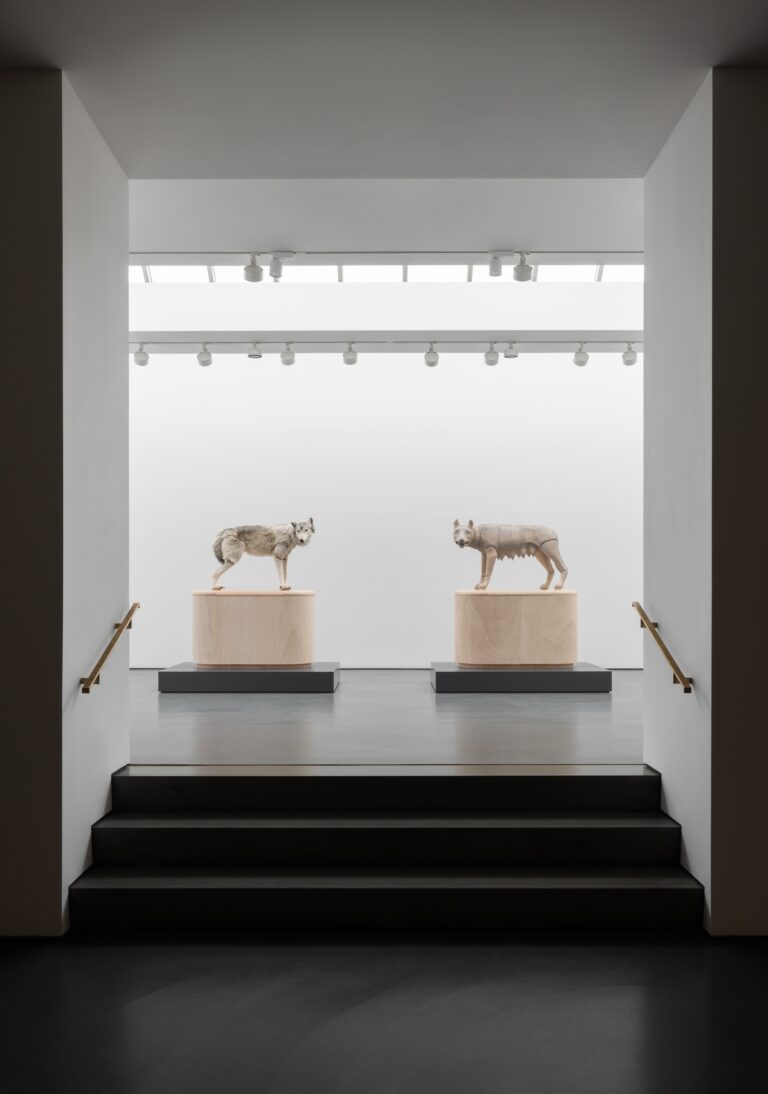
Left:
Julius von Bismarck
Zwei Wölfinnen (Im Wolfspelz), 2024
Wood, fur, winches, controllers, wooden plinth
154 x 131 x 63 cm (sculpture and plinth)
20 x 202 x 134 cm (pedestal)
Right:
Julius von Bismarck
Zwei Wölfinnen (Wilde Mutter), 2024
Wood, winches, controllers, wooden plinth
154 x 131 x 60 cm (sculpture and plinth)
20 x 202 x 134 cm (pedestal)
Exhibition view:
Julius von Bismarck, Zwei Wölfinnen, Esther Schipper, Berlin, 2024
Courtesy the artist and Esther Schipper, Berlin/Paris/ Seoul
© The artist / VG Bild-Kunst, Bonn 2024
Photo © Andrea Rossetti
Fierce creatures looming large in the humanity’s imagination, wolves are endowed with distinct attributes in different cultures: seen as brutal and unrelenting, doltish or menacing, greedy and destructive, or implicated with witchcraft and magical transformation (werewolf) in some, others associate the animal with independence and freedom (lone wolf), courage and strength, cunning and intelligence. A recurring motif has the wolf turn protector and caregiver of a human infants: most famously, Zoroaster, Romulus and Remus, Rudyard Kipling’s fictional character Mowgli—all were supposedly suckled by a she-wolf, raised by a pack of wolves.
Rendered nearly extinct in the late 18th and early 19th century, the fate of the wolf can be understood in a larger context of the domination of the natural world, specifically, as part of the Western European notion of the world as something to be domesticated, toiled upon, exploited. Increasingly demonized since the Middle Ages, Christianity emerges as major force in the demise of wolves, partially justified by the bible’s use of the animal as a symbol of danger to the flock and, in the warning of false prophets who are “wolves in sheep’s clothing,” to the soul.
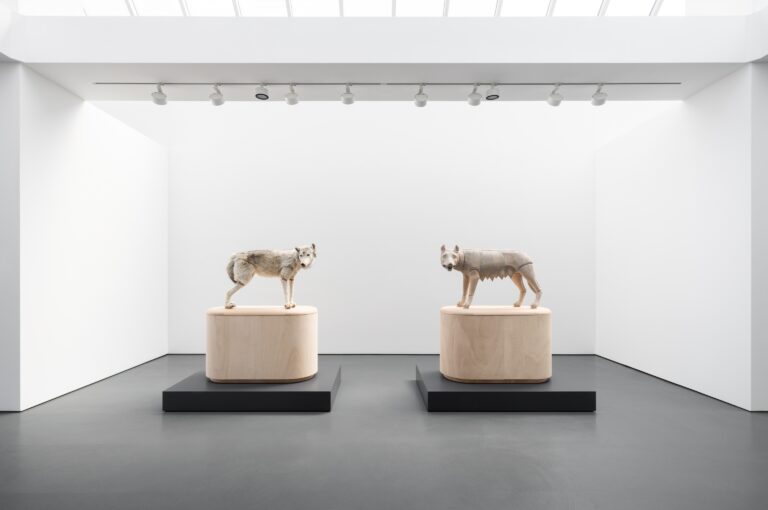
Left:
Julius von Bismarck
Zwei Wölfinnen (Im Wolfspelz), 2024
Wood, fur, winches, controllers, wooden plinth
154 x 131 x 63 cm (sculpture and plinth)
20 x 202 x 134 cm (pedestal)
Right:
Julius von Bismarck
Zwei Wölfinnen (Wilde Mutter), 2024
Wood, winches, controllers, wooden plinth
154 x 131 x 60 cm (sculpture and plinth)
20 x 202 x 134 cm (pedestal)
Exhibition view:
Julius von Bismarck, Zwei Wölfinnen, Esther Schipper, Berlin, 2024
Courtesy the artist and Esther Schipper, Berlin/Paris/ Seoul
© The artist / VG Bild-Kunst, Bonn 2024
Photo © Andrea Rossetti
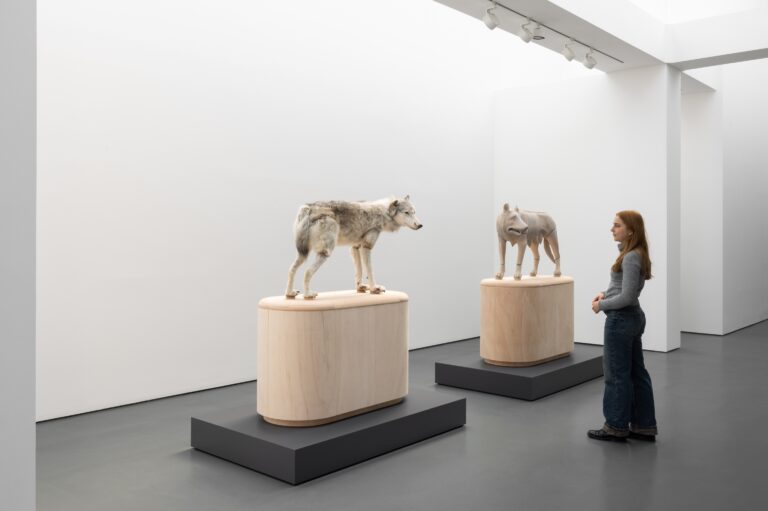
Left:
Julius von Bismarck
Zwei Wölfinnen (Im Wolfspelz), 2024
Wood, fur, winches, controllers, wooden plinth
154 x 131 x 63 cm (sculpture and plinth)
20 x 202 x 134 cm (pedestal)
Right:
Julius von Bismarck
Zwei Wölfinnen (Wilde Mutter), 2024
Wood, winches, controllers, wooden plinth
154 x 131 x 60 cm (sculpture and plinth)
20 x 202 x 134 cm (pedestal)
Exhibition view:
Julius von Bismarck, Zwei Wölfinnen, Esther Schipper, Berlin, 2024
Courtesy the artist and Esther Schipper, Berlin/Paris/ Seoul
© The artist / VG Bild-Kunst, Bonn 2024
Photo © Andrea Rossetti
Conceived as a pair, Bismarck’s two sculptures represent different aspects of lupine-human entanglement. Zwei Wölfinnen (Im Wolfspelz) at first looks the fierce creature, with its muscular body and rough coat, even as its posture slightly echoes that of its Roman companion. This echo hints at the essence of taxidermy: made from an animal skin drawn over a shape approximating a pose we may think of as typical, the taxidermied “animal” is a fantasy. Carved from wood, Zwei Wölfinnen (Wilde Mutter), is modelled on a version of the Capitoline bronze of a she-wolf. A politicized hybrid of the human fascination with the wolf, the Etruscan bronze—distributed in multiple variations across Italian sculptural representations—became a symbol for the capital Rome when in the 15th century, bronzes of two infants were added—the mythological founding fathers, Romulus and Remus. Bismarck’s sculpture leaves out the suckling infants, but the iconicity of the source lets observers almost unconsciously add them.
Then the illusion breaks—as with all taxidermied animals on closer inspection—when we see the large-scale figures collapse and reconfigure, revealing the elaborate construction that enables their continuous movement. A further development of Bismarck’s series of monumental collapsing sculptures presented in the artist’s solo exhibition at the Berlinische Galerie in 2023, the new works emulate the mechanism of hand-held push-puppet toys with miniature animals. Yet, the collapse of the animal’s body into sections—and with it the dissolution of the initial illusion of the animal sculptures’ intactness—brings with it a heady mix of power, curiosity and, as with many contemporary encounters with animals, pity and perhaps shame.
The format of Julius von Bismarck’s sculptures—their echoing the toy’s construction, anti-naturalistic awkward motions, and even the characteristic round base as plinth—has an anti-heroic effect: the imposing figures’ continuous collapse is a choreographed study in powerlessness, turning the predator Zwei Wölfinnen (Im Wolfspelz) and the iconic cultural symbol Zwei Wölfinnen (Wilde Mutter) into jumbled dolls. But transformed in scale, the playfulness of its mechanistic source comes with a change in scale of the inferred violence. The laughter at the sculptures’ unceremonious collapse becomes a symptom of our ambivalence at taking pleasure from this destruction and, in this realization, the wider consequences of humanity’s relation to the world are revealed.
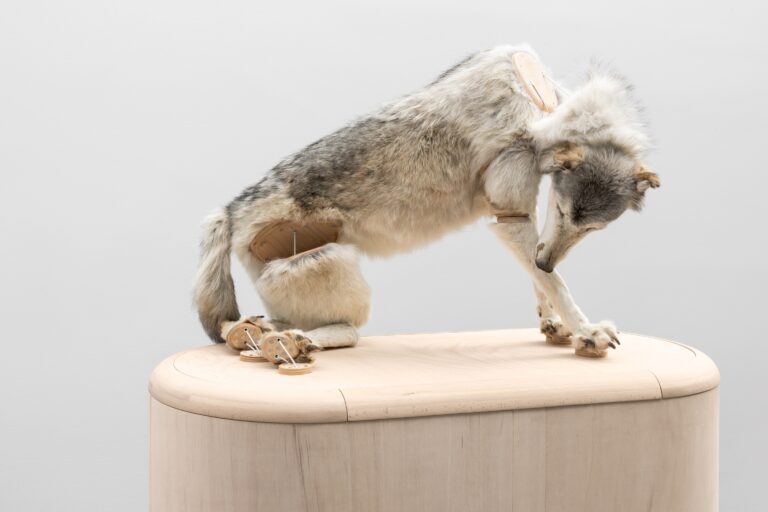
Julius von Bismarck
Zwei Wölfinnen (Im Wolfspelz), 2024
Wood, fur, winches, controllers, wooden plinth
154 x 131 x 63 cm (sculpture and plinth)
20 x 202 x 134 cm (pedestal)
Exhibition view:
Julius von Bismarck, Zwei Wölfinnen, Esther Schipper, Berlin, 2024
Courtesy the artist and Esther Schipper, Berlin/Paris/ Seoul
© The artist / VG Bild-Kunst, Bonn 2024
Photo © Andrea Rossetti
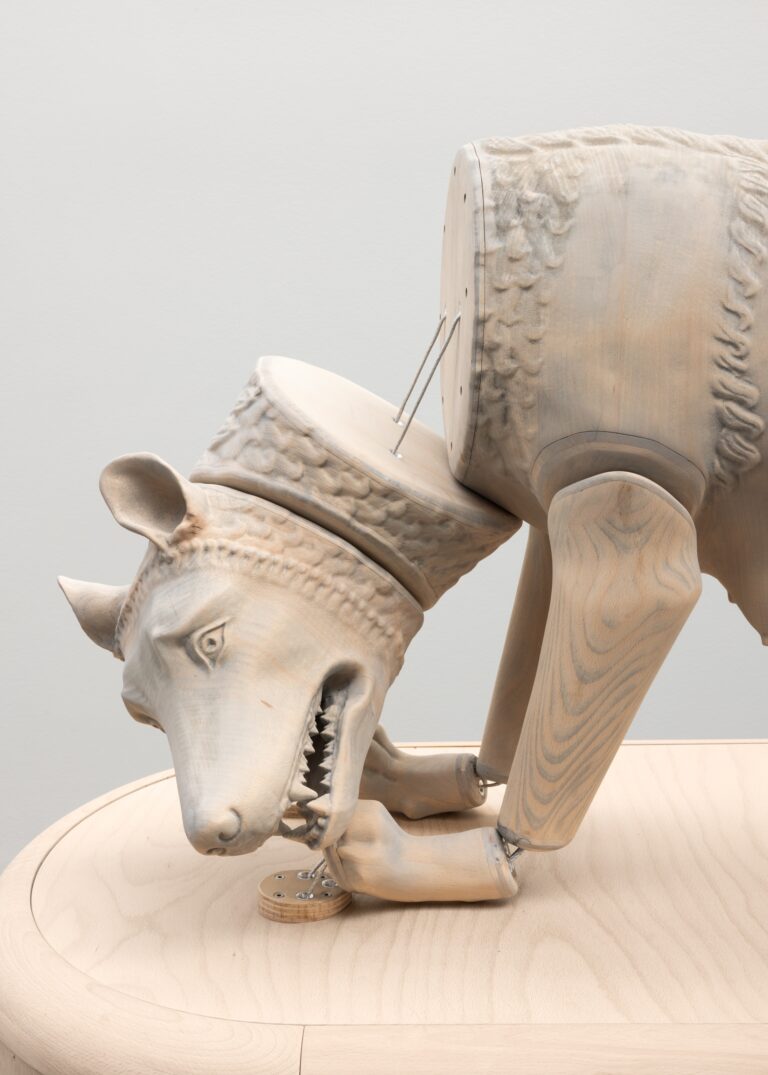
Julius von Bismarck
Zwei Wölfinnen (Wilde Mutter), 2024
Wood, winches, controllers, wooden plinth
154 x 131 x 60 cm (sculpture and plinth)
20 x 202 x 134 cm (pedestal)
Exhibition view:
Julius von Bismarck, Zwei Wölfinnen, Esther Schipper, Berlin, 2024
Courtesy the artist and Esther Schipper, Berlin/Paris/ Seoul
© The artist / VG Bild-Kunst, Bonn 2024
Photo © Andrea Rossetti
Zwei Wölfinnen then speaks to the core of Bismarck’s practice: the question of how the notion of Nature has been constructed, in particular, how the conceptual separation of man from his surroundings, through naming, classifying, and creating systems, has gone hand in hand with the control and domination of the environment, with increasingly disastrous consequences, not only for the planet, but also, as a consequence of broader notions of human sovereignty, for the lives of other beings, human and non-human.
Concurrent with his presentation at Esther Schipper, Julius von Bismarck will have a solo exhibition at alexander levy.
Julius von Bismarck, born 1983 in Breisach am Rhein, Germany, grew up in Riyadh, Saudi Arabia. He currently lives and works in Berlin and in Switzerland. The artist studied at the Berlin University of the Arts (2005-2013) and Hunter College, New York (2007). Julius von Bismarck received the Award of the Shifting Foundation, Beverly Hills (2018); IBB Photography Award, IBB Atrium, Berlin (2013); and Prix Ars Electronica Award, Linz (2009), among others. Julius von Bismarck’s recent solo exhibitions and commissions include: When Platitudes Become Form, Berlinische Galerie. Museum für Moderne Kunst, Berlin (2023); NEUSTADT (with Marta Dyachenko), Emscherkunstweg, Duisburg (2021); Feuer mit Feuer, Bundeskunsthalle, Bonn (2020); Art Club #28, Villa Médicis – Académie de France à Rome, Rome (2019); Baumanalyse, Haus Mödrath – Räume für Kunst, Kerpen (2019); Die Mimik der Tethys, Palais de Tokyo, Paris (2019); I’m afraid I must ask you to leave (with Julian Charrière), Kunstpalais Erlangen, Erlangen (2018); Gewaltenteilung, Städtische Galerie Wolfsburg, Wolfsburg (2017); Objects in mirror might be closer than they appear (with Julian Charrière), Villa Bernasconi, Geneva (2016); Fade Into You – A Series of Film Screenings, Kunsthalle Mainz, Mainz (2016); Tiere sind dumm und Pflanzen noch viel dümmer, Kunstverein Göttingen, Göttingen (2015); History Apparatus, Kunstverein Arnsberg, Arnsberg (2014).
His work is held in the collections of various institutions including: Arken Museum, Ishøj; FRAC Alsace, Sélestat; Fundación Televisa, Mexico City; Kunsthalle Hamburg; Musac – Museo de Arte Contemporáneo de Castilla y León; Sammlung Philara, Düsseldorf; Sammlung zeitgenössischer Kunst der Bundesrepublik Deutschland, Bonn; Sprengel Museum Hannover, Hanover; and Stadtgalerie Wolfsburg.
For press inquiries please contact David Ulrichs. Tel: +49 (0) 176 50 33 01 35 or david@davidulrichs.com
Ann Veronica Janssens
spring show
Opening – 26 APR 2024, 6-9 pm
Esther Schipper is pleased to announce spring show, Ann Veronica Janssens’ sixth solo exhibition with the gallery. Coming just a year after the artist’s celebrated solo presentation at Milan‘s Pirelli HangarBicocca, spring show brings together a wide range of new and historical works by Janssens.
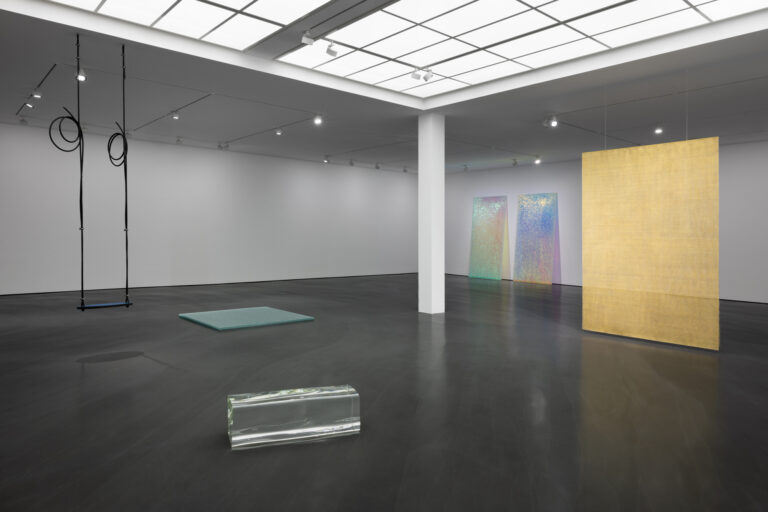
Ann Veronica Janssens, spring show,
Esther Schipper, Berlin, 2024
Courtesy the artist and Esther Schipper, Berlin/ Paris/ Seoul
© The artist / VG Bild-Kunst, Bonn 2024
Photo © Andrea Rossetti
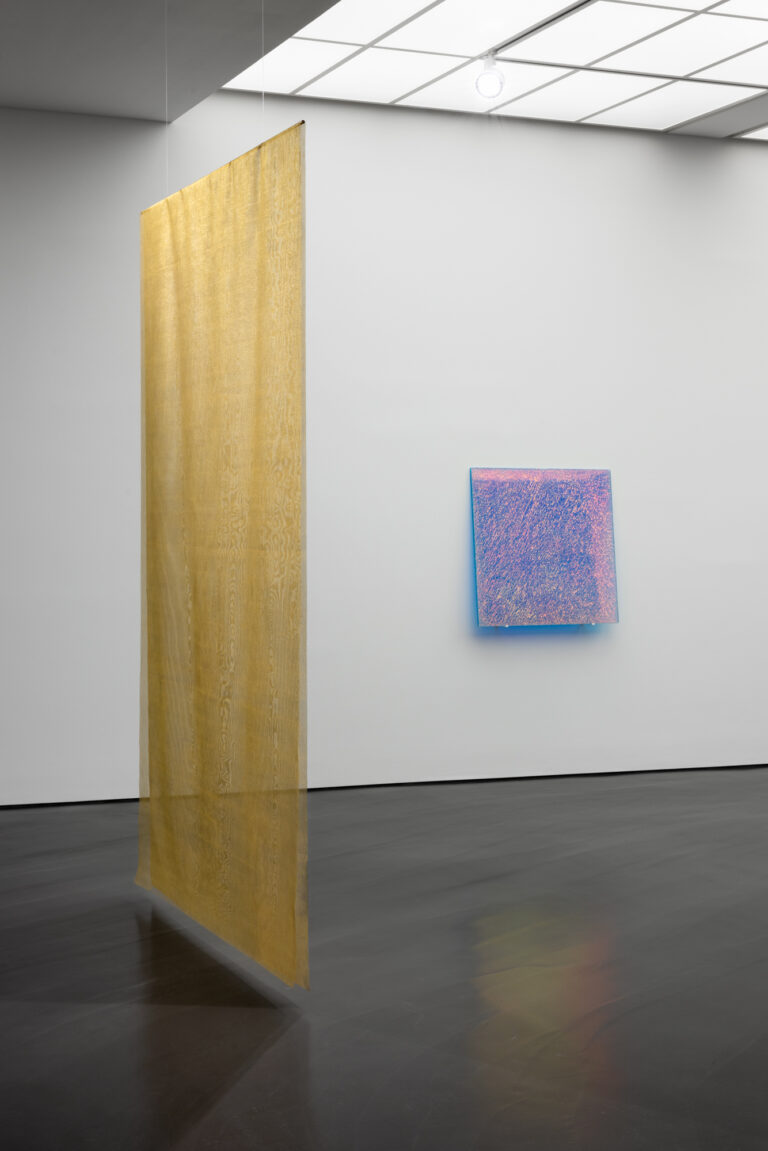
Left:
Ann Veronica Janssens
Heat, 2024
Gilded mosquito net
291 x 200 x 1 cm
Right:
Ann Veronica Janssens
Magic Mirror Chill Sapphire, 2024
Dichroic laminated glass consisting of crash glass,
float glass and gelatin filters
100 x 100 x 2 cm
Exhibition view:
Ann Veronica Janssens, spring show, Esther Schipper, Berlin, 2024 Courtesy the artist and Esther Schipper, Berlin/ Paris/ Seoul
© The artist / VG Bild-Kunst, Bonn 2024
Photo © Andrea Rossetti
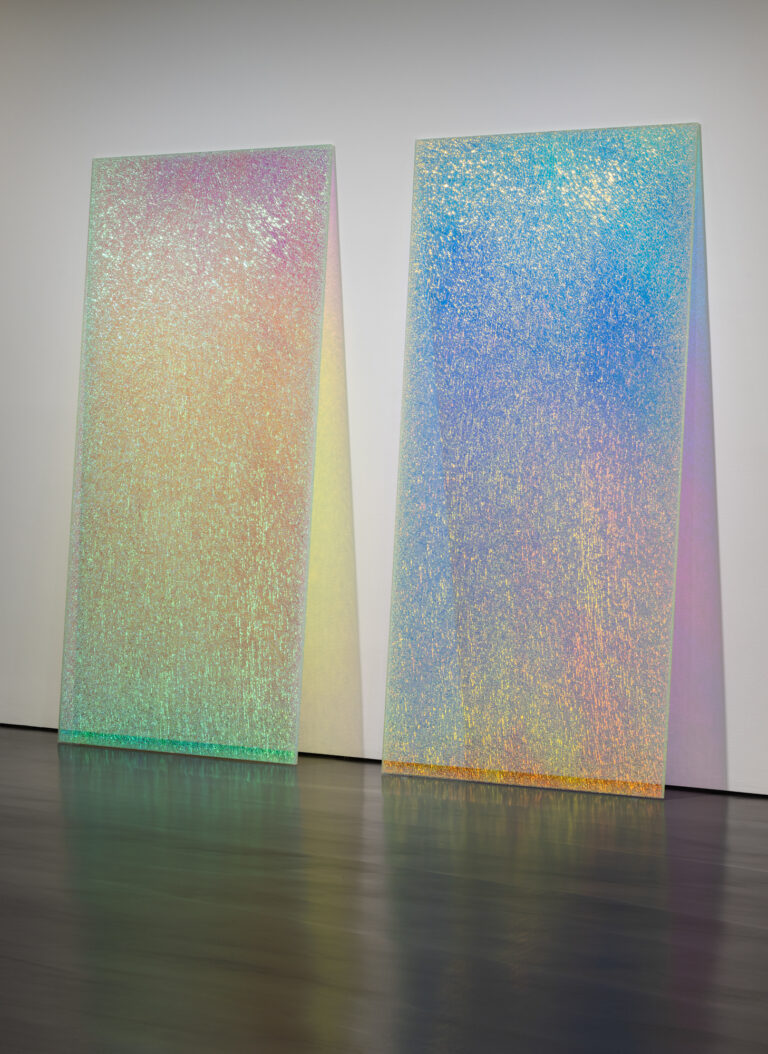
Ann Veronica Janssens
Magic Mirrors (Pink & Blue), 2013-2023
Dichroic laminated glass consisting of crash glass,
float glass and gelatin filters
Diptych
300 x 150 x 1,8 cm
Exhibition view: Ann Veronica Janssens, spring show, Esther Schipper, Berlin, 2024
Courtesy the artist and Esther Schipper, Berlin/ Paris/ Seoul
© The artist / VG Bild-Kunst, Bonn 2024
Photo © Andrea Rossetti
Since the late 1970s, Janssens has developed an artistic practice based on light, color, and natural optical phenomena. She continuously experiments with the characteristic attributes of carefully chosen materials (glass, mirrors, aluminum, artificial fog), shapes, and light, wielding our perception of reality as her medium. Her works give the impression of great simplicity yet create vivid experiences of the act of seeing. With their sense of constant transformation, the works heighten the viewers awareness of the mutability and transience of human cognition.
Featuring a careful arrangement of works, spring show in subtle ways materializes the empty space between them. Janssens’ “performative sculptures” require observers to move to fully experience them. Each has its own experiential rhythm, as if requiring a set of gestures from visitors to unlock their essence. We peer into the blocks of optical glass and tilt our head to see the light caught in their interior or step back and forth before the panels holding shattered security glass to see their kaleidoscopic colors and luminous spatial effects. Retracing our movement to recapture a color or effect, and finding it changed and not reproducible, the act of looking and the singularity of each experience becomes the focus of spring show.
The invitation to interact is made even clearer by Swings, which invite us to sit down and feel the air rush past our face, experiencing simultaneously the materiality and the transparency of air. Covered in a heat-reactive film, the seat of the swing reacts to the warmth of the body, and the rainbow-colored traces become part of the sculpture, before slowly disappearing again. There is also a mnemonic aspect to the movement: it takes us back to childhood and the delight in the dizzying effects of disorientation. The natural world, caught in a dialectic of abstraction and figuration, is the subject of Atlantic. Characteristic in its elegant simplicity, a pile of nine panes of hammered glass immediately evokes its namesake, and with it, the hypnotic calm of watching the sea.
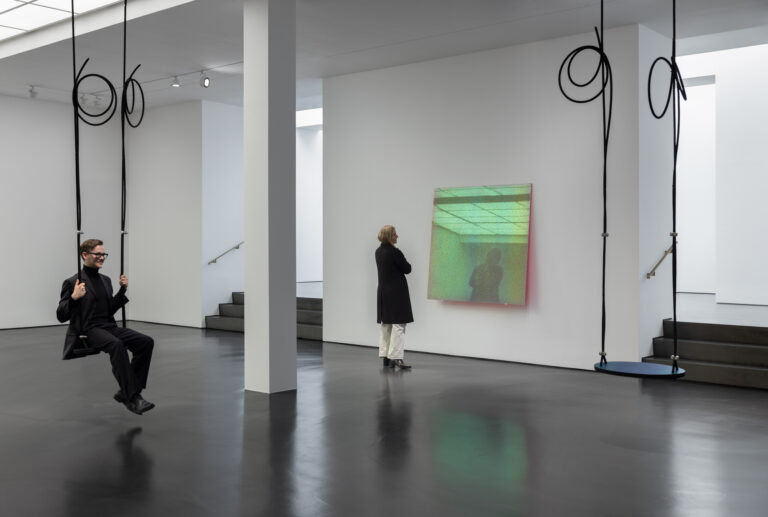
Exhibition view:
Ann Veronica Janssens, spring show, Esther Schipper, Berlin, 2024
Courtesy the artist and Esther Schipper, Berlin/ Paris/ Seoul
© The artist / VG Bild-Kunst, Bonn 2024
Photo © Andrea Rossetti
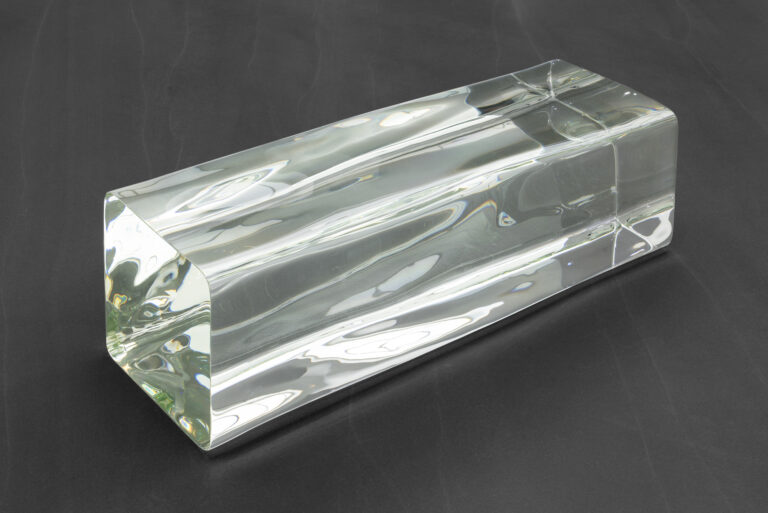
Ann Veronica Janssens
Untitled, 2019-2023
Optical glass
30,5 x 99,2 x 31,5 cm
Exhibition view:
Ann Veronica Janssens, spring show, Esther Schipper, Berlin, 2024
Courtesy the artist and Esther Schipper, Berlin/ Paris/ Seoul
© The artist / VG Bild-Kunst, Bonn 2024
Photo © Andrea Rossetti
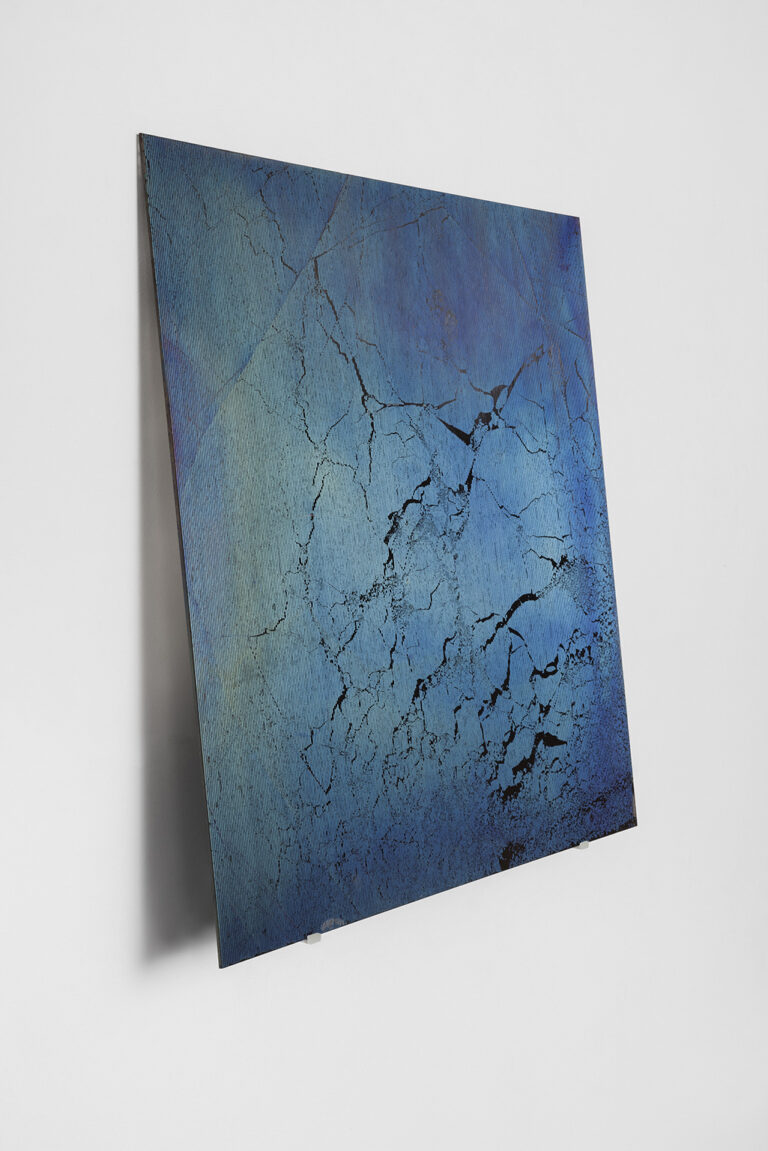
Ann Veronica Janssens
31.05.23, 2023
Ribbed glass, structural colors
100 x 100 x 0,6 cm
Exhibition view:
Ann Veronica Janssens, spring show, Esther Schipper, Berlin, 2024
Courtesy the artist and Esther Schipper, Berlin/ Paris/ Seoul
© The artist / VG Bild-Kunst, Bonn 2024
Photo © Andrea Rossetti
Works from the series Structural Color, panels of ribbed glass covered with a sophisticated bio-chemical nanofilm coating that produces enigmatic forms and colors in a spectrum broader than pigment, attest to Janssens ceaseless experimentation. Developed in collaboration with Dr. María Boto Ordóñez, scientific researcher at KASK/School of Arts of University College Ghent, the process creates microscopic structural layers that interfere with visible light. The work’s delicacy is akin to a butterfly’s wing, where this type of color occurs in nature. Any direct touch will destroy the microscopic structure that creates the perception of iridescent colors; the object’s vulnerability is another important recurring theme in Janssens’ practice. At the same time, Structural Color draws attention to the singularity and mutability located in our perception: with each glance, color modulations and forms appear transformed, each glance is unique and irretrievable.
Janssens’ emphasis on the present moment and the ephemerality of perception, comes with a leavening of immutability and force. Glass after all is both easily broken yet also incredibly strong and durable. Its beauty harbors an element of danger. The shattered security glass of Magic Mirror Chill Saphire is an embodiment of this, as is the inherent dichotomy of a controlled destruction, a pattern from thousands of minute accidental breaks that can be traced to one action. Heat, a new work from the artist’s series of gold-leaf covered objects, beautifully encapsulates this tension: made from gilded mosquito netting, Heat can be understood as complex deliberation on contemporary life and ecology. The net, a material used to avert nuisance but also illness, is covered in a substance that, with its sunny glow, represents both the warmth of energy and its potentially destructive force. The work makes visible the movement of the air, as it is gently animated by the breeze (created perhaps by a fellow visitor, swinging through the space nearby), and with it, with subtly beauty, the connection between all things, of all beings at any moment in time becomes apparent.
Ann Veronica Janssens was born in 1956 in Folkestone, England. She studied at L’École de la Cambre in Brussels. The artist lives and works in Brussels.
Among her numerous solo exhibitions are: pinkyellowblue, M Woods Museum, Beijing (2023); Grand Bal, Pirelli HangarBicocca, Milan (2023); Entre le crépuscule et le ciel, Collection Lambert, Avignon (2022); 23:56:04, Panthéon, Paris (2022); 5766 chemin des Trious, Fondation CAB, Saint-Paul-de-Vence (2022); gam gam gam, Galleria d‘Arte Moderna – GAM, Milan (2021); Hot Pink Turquoise, South London Gallery, London (2020–21) and Louisiana Museum of Modern Art, Humlebæk (2020); Green, Yellow and Pink (as part of CONNECT, BTS), Dongdaemun Design Plaza (DDP), Seoul (2020); Ann Veronica Janssens, De Pont Museum, Tilburg (2018–19); Ann Veronica Janssens, Kiasma Museum of Contemporary Art, Helsinki (2018–19); mars, IAC, Villeurbanne/Rhône-Alpes (2017); Ann Veronica Janssens, Nasher Sculpture Center, Dallas (2016); Ann Veronica Janssens: yellowbluepink, Wellcome Collection, London (2015);
Janssens‘s work is held in the collections of Caldic Collection – Museum Voorlinden, Wassenaar; De Pont Museum, Tilburg; Institut d‘art contemporain Villeurbanne/Rhône-Alpes; FNAC, Paris; Les Abattoirs – FRAC Midi-Pyrénées, Toulouse; FRAC Nord-Pas-de-Calais, Dunkerque; 49 Nord 6 Est – FRAC Lorraine, Metz; FRAC Aquitaine, Bordeaux; FRAC Bourgogne, Dijon; FRAC Pays de la Loire, Carquefou; FRAC Languedoc-Roussillon, Montpellier; FRAC Corse, Corte; FRAC Franche-Comté, Besançon; Fundación Jumex, Mexico City; Louisiana Museum of Modern Art, Humlebæk; mac, Marseille; Mona – Museum of Old and New Art, Tasmania; MUHKA, Antwerp; Musée national d‘art moderne – Centre Pompidou, Paris; Musées royaux des Beaux-Arts de Belgique, Brussels; Museu Coleçao Berardo, Lisbon; Mu.ZEE, Oostende; Musée des Arts Contemporains – Grand Hornu; Nasher Sculpture Center, Dallas; S.M.A.K., Gent; Tel Aviv Museum of Art, Tel Aviv.
For press inquiries please contact David Ulrichs. Tel: +49 (0) 176 50 33 01 35 or david@davidulrichs.com
